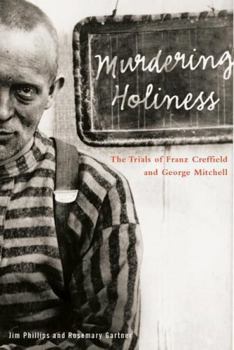Murdering Holiness: The Trials Of Franz Creffield And George Mitchell
Murdering Holiness explores the story of the "Holy Roller" sect led by Franz Creffield in the early twentieth century. Creffield, a charismatic, self-styled messiah, taught his followers to forsake the worldliness of material goods and their families and seek only salvation. As his teachings became more extreme, the local community reacted by tarring and feathering him and incarcerating his mainly female followers in the asylum and other institutions. Creffield himself was imprisoned after a conviction for adultery, but shortly after his release he revived the sect. George Mitchell, the brother of two of Creffield's female followers, pursued him to Seattle and shot him dead. In a trial that made headlines across America, Mitchell was acquitted, ostensibly on the basis of insanity but in reality because of the "unwritten law" that justified killing in defense of a female relative who had been sexually "wronged." Mitchell himself was murdered two days after his acquittal by his own sister, Esther, whom he had claimed to be defending. In the final twist to this gripping story, Esther did not stand trial for the murder of her brother but was placed in the asylum, ultimately taking her own life by poison a few years later. In this fascinating micro-history, Phillips and Gartner explore the relationships among formal and informal law, gender relations, and religious repression. It will interest scholars and general readers in law, religion, and gender, as well as anybody interested in the history of Oregon and Washington in the early twentieth century.
Format:Hardcover
Language:English
ISBN:077480906X
ISBN13:9780774809061
Release Date:January 2003
Publisher:UBC Press
Length:352 Pages
Weight:1.40 lbs.
Dimensions:1.2" x 6.5" x 9.2"
Customer Reviews
1 rating
A Bizarre Story of a Religious Cult
Published by Thriftbooks.com User , 21 years ago
We are used to hearing about religious cults led by one charismatic individual. Our times have no monopoly on such cults, of course; our nation's tradition of freedom of worship encourages them, and we look toward economic or societal means to subdue the most flagrant ones, since the law cannot touch them if they are merely worshipping in some sort of erroneous way. _Murdering Holiness: The Trials of Franz Creffield and George Mitchell_ (University of British Columbia Press) by Jim Phillips and Rosemary Gartner resurrects a forgotten case which is part of our nation's history of cults, religious freedom, vigilantism, and the insanity defense. Phillips and Gartner, professors in law and criminology at the University of Toronto, have produced a detailed and closely researched history of the incident, and an entertaining one as well.Franz Creffield was an itinerant preacher who arrived in Corvallis, Oregon, in 1902, and drew almost all its Salvation Army members into his "Army of Holiness," though they were also known as "Holy Rollers," the first time that pejorative was every applied. He taught that the world was about to end, that wealth was bad, and that he could perform sexual purification of female converts. This got him tarred and feathered and run out of town. He was imprisoned for two years for adultery, and after his release, he was in Seattle in May 1906 when George Mitchell, a young laborer from Corvallis, walked up behind him and shot him in the neck on a busy Seattle street. Mitchell was acting to avenge the seduction and deflowering of his sister Esther, although she would have denied such a thing had happened. A temporary insanity defense was mounted, but the newspapers and most legal authorities agreed that Mitchell had done the manly thing. Mitchell was acquitted, and his sister Esther and Creffield's widow started talking about getting revenge. Days after the acquittal, at an ostensible meeting to make peace, Esther shot and killed her brother George at the train depot; she was eventually to say that God had commanded the act. The second murder caused an even bigger sensation, but the press seemed to think that honor killings were what men should do for women, not vice versa. An insanity commission arranged for her to go to the asylum rather than the penitentiary, and she was released after some years to return to her family. She seemed happy, she married in April 1914, and she killed herself by poison in August. It is a strange end to a strange story. Creffield had pursued his religious vision with passion and sincerity; George Mitchell killed him, risking his own life on the scaffold because of what society thought was a virtuous defense of his sister; Esther Mitchell's faith was strong enough that she could kill even her brother. The authors have included many insights into religious, legal, social, and psychological history of the times in a fascinating and dispassionate case study.





